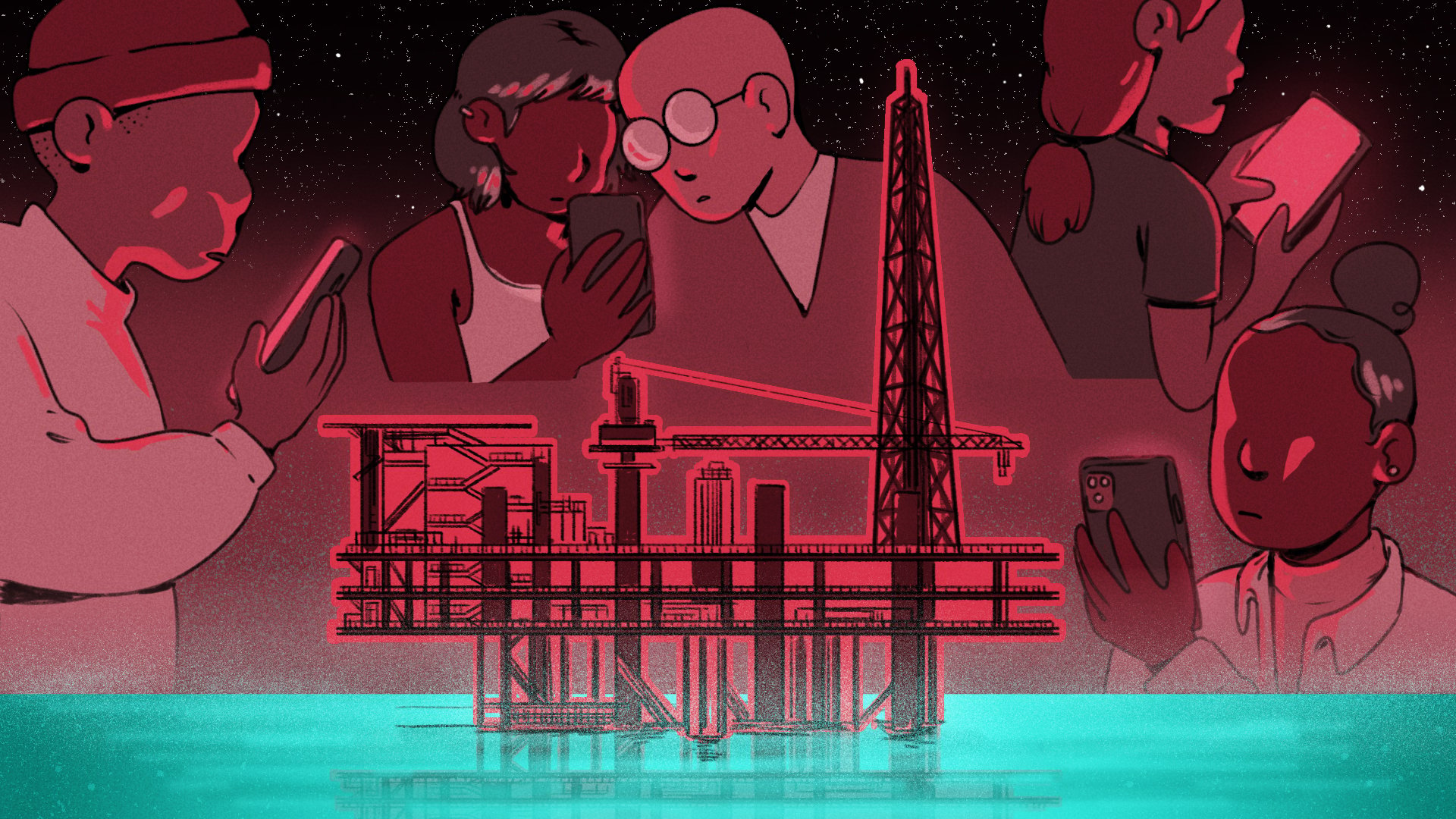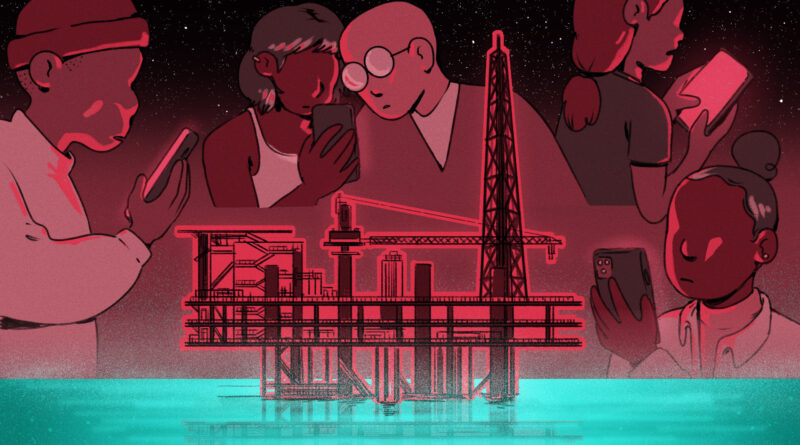The guilty pleasure of North Sea TikTok and its dystopian oil influencers

I’ve never been particularly into the sea (is anyone into the sea?). As hard as it might be to believe, unless I’m in the immediate vicinity of a big body of water, it’s not something that regularly crosses my mind. And yet this past year, I’ve spent more time thinking about the sea than ever before. Most of the time, it’s been off the back of increasingly ridiculous sea-related news stories – revenge-seeking orcas sinking boats; billionaires imploding near the wreck of the Titanic – but sometimes it’s been an obsession seemingly of my own making, like my TikTok algorithm feeding me an endless stream of shark videos.
If the intention is to make me fear the sea, though, then it’s North SeaTok that’s done it. Over the last month or so, my feed – just like everyone else’s – has been dominated by videos of the treacherous North Sea; more specifically, its oil rigs and the people who work on them.
The clips, some of which are getting up to 100 million views, tend to follow the same pattern: boats being violently tossed around by massive waves, offshore workers dangling from oil rigs or almost being swept out to sea, the occasional orange being thrown into pitch black nothingness. They’re mostly soundtracked by the same creepy version of the sea shanty, “Hoist the Colours,” which – sing it with me – goes: “Yo ho, all hands / Hoist the colours high / Heave ho, thieves and beggars / Never shall we die.”
You might be thinking: OK, so what? People have always been fascinated by the frightening depths and power of the sea – even TikTok is no exception (see: Drake PassageTok). But what you should be asking is: who’s going to reap the rewards of this virality?
As the North Sea itself can’t capitalise on its newfound notoriety (sad!), offshore workers are doing it instead, documenting their lives on the oil rigs, giving rig tours, doing offshore daily routines, and making memes about the work. Unlike the nightmarish North Sea montages, workers tend to show the mundanity of life inside the rig: watching Netflix in their clinical bedrooms, themed dinners in the canteen, and working or hanging out in the gym, sauna, or ‘hobby’ rooms. It’s less, “We’re all going to die,” as TikTok would have you believe, and more, “Working cruise with the lads.” One oil rig creator, @lifeofamalie, who has 45k followers, has even started stitching the viral videos to debunk them.
That said, the montages are real, so there is some truth to them. “You do have people swinging about from the steelwork, but it’s very well-controlled and safe,” confirms 45-year-old Colin from Perthshire in Scotland, who’s worked offshore for over 15 years, and now posts about it on TikTok as V9 Media. “Well, as safe as it can be hanging on to two tiny ropes.” Colin himself is an industrial electrician, so can be found climbing around and dangling off the rig at night. “The work is usually quite dirty,” he adds. “And it’s a noisy environment with machinery running everywhere. It’s also normally cold and windy.”
Colin, like a lot of offshore workers, works three weeks on, three weeks off, including on wind turbine vessels, which he likens to prison, but admits “is usually good craic”. Although, he adds: “You need thick skin, as there’s a lot of characters and relentless, good-natured piss taking that wouldn’t be allowed in a normal onshore working environment.”
The terrifyingly turbulent weather can be true to life, too. “I’ve had a few scary moments with wind and waves,” Colin continues. “The rigs themselves can also occasionally shut down, causing serious vibrations and noise. I’ve never seen anybody panic, though. We’re all well-trained and know what to do if something serious happens, so everybody just accepts it. Although if you plucked a civvy off the street, I’m sure most would be terrified.”
Like Colin, many of these workers were posting about oil rigs before North SeaTok took off, but have seen their follower counts jump in recent weeks. Some of them have even become bizarre oil rig influencers, gaining tens and even hundreds of thousands of followers. Their videos tend to be flooded with commenters asking about life and work on the rig, as well as how they can get into the industry themselves. As Colin notes: “Most people on TikTok seem to think we’re all millionaires.”
“Most people on TikTok seem to think we’re all millionaires.”
Although the majority of the oil rig creators I’ve come across appear to be making content of their own accord, this might not be the case for long – or even the case at all. Employers encouraging, or even paying, their employees to boost a brand’s profit or reputation by posting on TikTok isn’t new. Companies like Sephora, Chipotle, and Dunkin’ Donuts have all benefited from employee influencers, whether they encouraged it or not. You can see the draw of this for big oil companies, too, whose reputation is, rightly, in tatters; if they can humanise the industry by framing it through the eyes of happy, well-paid employees, then maybe they can shift focus from the climate catastrophe they’re – quite literally – fuelling (Britain’s oil and gas rigs are the most polluting in the North Sea, releasing as much carbon dioxide as a coal-fired power plant).
This isn’t a far-fetched idea – it’s already happening. Earlier this year, it emerged that fossil fuel giants, like Shell and BP, both of which operate in the North Sea, were employing UK influencers to push false solutions to the climate crisis and, importantly, to revamp their image. In October, for example, it was revealed that Shell had partnered with popular gamers to promote fossil fuels via Fortnite. As per DeSmog, leaked documents showed how BP hoped to use influencers to become “more relatable, passionate, and authentic” and to convince young people that they’re not “the bad guys”.
Granted, there’s little evidence that this is what’s happening with the oil rig influencers, most of whom don’t even declare who they work for. Though one creator, who documents her experience as a woman on the rig and encourages other women to enter the industry, did share a dystopian-looking cake decorated with the Shell logo. “Companies can be extremely strict on their confidentiality when it comes to practices, hence the reason I’ll never disclose the platform I work on, the company I work for, nor the duty holder,” says 28-year-old Mosey, an offshore mechanical technician from the north west of England who boasts almost 30k followers on TikTok. “But I think it’s great that videos are being posted. It gives people more of an idea of what life is like on an oil and gas platform. It shows the benefits as well as the negatives.”
“It gives people more of an idea of what life is like on an oil and gas platform. It shows the benefits as well as the negatives.”
Still, this boom and the intrigue around it is having what could be considered a desired effect for big oil companies: young TikTokkers, seemingly watching the lifestyle longingly, are asking how to get into oil and gas.
That’s not to say it’s a bad thing that these influencers exist. They’re providing rarely heard insight into their brutal and often thankless work, and showing the camaraderie that exists in such a dangerous workplace. Plus, as many of the oil rigs in the North Sea are in the process of being decommissioned (which raises controversies of its own), any independent documentation of this mysterious world is worthwhile. This is partly why Mosey started posting on TikTok in the first place. “It’s very difficult to get insight into the offshore lifestyle, so a lot of people go in blind,” he explains. “I was in that exact situation before I got my job offshore only three years ago, so I’d like to provide some information from my experience of what the industry is like.”
The problem arises when/if the big oil bosses start capitalising on the success of their employees – will those who’ve organically grown their platform be incentivised by money or other perks to peddle false information about the broader oil and gas industry? As they’re employees, would they have to declare this as sponsored content on platforms like TikTok, or can they embed messages covertly?
At a time when almost anyone has the means to become an influential micro-celebrity, the potential for this to be abused by employers – especially evil ones like Shell and BP – can’t be ruled out. But, like with most things on TikTok, the tide will soon turn on the North Sea, and employees in a different industry will be raking in the views. So hopefully big oil has already missed its chance.
For now, one thing’s for sure: I’d rather be swallowed up by the tempestuous waves of the North Sea than ever hear “Hoist the Colours” ever again.
